- News
- Reviews
- Bikes
- Accessories
- Accessories - misc
- Computer mounts
- Bags
- Bar ends
- Bike bags & cases
- Bottle cages
- Bottles
- Cameras
- Car racks
- Child seats
- Computers
- Glasses
- GPS units
- Helmets
- Lights - front
- Lights - rear
- Lights - sets
- Locks
- Mirrors
- Mudguards
- Racks
- Pumps & CO2 inflators
- Puncture kits
- Reflectives
- Smart watches
- Stands and racks
- Trailers
- Clothing
- Components
- Bar tape & grips
- Bottom brackets
- Brake & gear cables
- Brake & STI levers
- Brake pads & spares
- Brakes
- Cassettes & freewheels
- Chains
- Chainsets & chainrings
- Derailleurs - front
- Derailleurs - rear
- Forks
- Gear levers & shifters
- Groupsets
- Handlebars & extensions
- Headsets
- Hubs
- Inner tubes
- Pedals
- Quick releases & skewers
- Saddles
- Seatposts
- Stems
- Wheels
- Tyres
- Health, fitness and nutrition
- Tools and workshop
- Miscellaneous
- Tubeless valves
- Buyers Guides
- Features
- Forum
- Recommends
- Podcast
feature
 Header
HeaderI’d never cycled up an Alpine pass before. Here’s what I learned
I like France. I like the weather, I like the wine, I like the ferocious commitment to serving up ham and cheese in as many different forms as possible. I also like the mountains. However, one thing I had never done before this summer was ride a bike up a proper, full-on, oversized Alpine mountain.
I’ve been to the Alps a number of times before, usually in winter, and I’ve also cycled elsewhere in France a fair bit – mostly when riding from the northern coast down to the southern coast with my dad a few years ago. (He was 70 at the time. Chapeau, Dad.)
Riding up Alpine passes is a thing though, isn’t it? Riding up Alpine passes is very definitely a big and obvious cycling thing. I know it is. I have seen the Tour de France with my eyes and read cycling articles also with my eyes.
It felt like something I wanted to experience with my legs, so I went to Samoens, which is at the exact bottom of the Col de Joux Plane.
Could you cycle up an Alpine pass?
It was easy enough to think through my previous cycling experiences, mash a few of them together in my head and draw the assumption that I could easily ride up an Alpine pass.
At the same time – and given that I had never actually ridden up an Alpine pass, I was almost equally capable of persuading myself that it was some unimaginable feat that was entirely beyond me.
Key to this was a memory of cycling up a not-particularly-steep 10km climb in Provence and really, properly labouring by the end of it. The circumstances were that it was 37 degrees, I’d run out of water about an hour before and I’d just finished cycling the entire length of France. (I don’t know what gearing I was using then either.)
These mitigating factors did somewhere near nothing to mitigate my apprehension. All I could do was compare that fairly innocuous gradient with the ones we’d be tackling this time around.
And this is the first thing I learned about riding up Alpine passes: you form insanely strong opinions about very minor changes in gradient. (More on this later.)
Le Col de Pierre Carrée
The first climb we attempted was the Col de Pierre Carrée. We chose this for two reasons.
- While it was unarguably long, at about 28km, it wasn’t quite so steep as some of the others in the area, averaging 4.9%. The full 28km comprises a couple of shorter climbs and then the proper road sign countdown starts with about 14km to go. That stretch is pretty consistently 6-7%.
- Le Col de Pierre Carrée (sort of) means Square Pierre Pass. One of my riding companions is also called Alex, but we entirely arbitrarily rebranded him “Pierre” some years ago to avoid confusion. As you’d imagine, we felt obliged to ride the Square Pierre Pass.
How did it go? Um. It was hot. And we maybe started a little too fast (particularly considering that my other friend, Marcus, hadn’t ridden a road bike since 2017).
With about 6km to go, Marcus expressed a desire to go and sit in the shade for a moment. Upon hearing this, Pierre – who had been cycling five yards ahead of us, looking for all the world like nothing was remotely troubling him – instantly climbed off his bike and went and sat in a stream.
We completed the climb at a more leisurely pace and it was great and lovely and I immediately felt like we hadn’t really done it properly because we’d stopped.
Afterwards, we sat outside a café until a giant road-digging-up machine went past and dug up the road, showering the whole place in powdered asphalt.
I had a cheese and ham pancake. (Other ways in which I ate cheese and ham this holiday: tartiflette x1, panini x1, “pain au lard” x 1, pizza x3, sandwiches x400.)
Here’s the pain au lard, which I had at the foot of the Pierre Carrée. It was bloody delicious.
Le Col de la Ramaz
The day after going up the Pierre Carrée, I felt unusually fine. This is the second thing I learned about riding up Alpine passes: you can probably do more of them than you think.
A thousand metres of climbing in the Peak District generally leaves me fully aware that it’s happened the following day. Climbing on the consistent gradients of the Alps, you simply don’t do as much damage to yourself.
You could. You definitely could. But if you know it’s going to take you about an hour to get from bottom to top, you’ll find you naturally measure your effort and that this particular effort isn’t as debilitating as the effort a British road will trick you into.
On a long climb, you settle into a rhythm; a rhythm that is by necessity sustainable. Sustainable efforts are also a lot more repeatable. Throw in a lot less sprinting for the top - because you only very rarely find yourself at a 'top' - and you've got a nice recipe for plenty more riding than you probably envisaged.
I couldn’t go out the next day though because I have a family and am not a complete arsehole.
I went out the day after instead.
Marcus was off mountain biking and Pierre had tested his legs the day before and not been 100 per cent delighted with them, so we hit on a plan where I’d ride to Morzine over the Col de la Ramaz and he’d come some of the way with me but then take “the low road” to the same destination. (Turned out “the low road” involved 11km at 5%)
The Ramaz was a bit more than that – 14km at 7%. Although he was going a different way, Pierre made a point of climbing it as far as Messy because he entirely understandably wanted to set himself up for some puns later on.
He wisely missed out on the 5km at 9.5% that comes halfway up. Even with compact gearing I did not find this stretch magnificent. (Top tip: always try and own a mediocre bike. That way if you hire one on holiday, it’ll probably be better than yours and it’ll feel like a treat. For much the same reason, never buy too large a television. You’ll quickly become accustomed to it and all that’ll happen is you’ll feel mildly irritated whenever you’re watching something round at a friend’s house.)
I was happy to get to the top without stopping and exchanged obligatory summit photo-taking duties with a bunch of blokes from either Normandy or Brittany – I’ve forgotten which.
I then settled in for the long descent to Morzine, which turned out not to be a long descent at all, but in fact a second climb to the Col de l’Encrenaz, which I had foolishly assumed was a mere staging post midway up the climb from Morzine to the Ramaz.
The Encrenaz was a lot more irregular and infuriatingly like riding in the Peaks, only hotter. It did however bring the greatest highlight of my entire trip, which was this guy.
I spoke to two other cyclists while I was refreshing myself. Both were training for the Tour d’Étape.
Main thing I’ve learned about people doing the Étape: they absolutely bloody love talking about the Étape.
The first guy talked me through the entire route. The second guy talked me through his entire training, while simultaneously giving me absolutely zero sense of how fit I would need to be to complete the event, which was about the only thing I really wanted to know.
It’s nice to stop and chat to people, but towards the end of the conversation I was becoming acutely aware that I was going to be very late meeting Pierre and I also wanted this guy to ride away before I took a photo of the water-spewing unicorn/alpaca thing.
Le Col de Joux Plane and Avoriaz
A couple of days later, we felt it was time to tick off the Joux Plane, the best-known climb in the area and among the nastiest. (11.5km at 8.5%)
Two men passed us on the lower slopes: a young man – out of the saddle and seemingly intent on maintaining that all the way to the top – and a much older guy.
Both were in their own ways remarkable, but I was far more struck by the latter. Maybe if he were a younger man, he would have looked sickly thin, but his advanced years instead gave the impression that this was a man progressing to becoming a skeleton in instalments.
It was pretty clear he had done this before. Many times. The guy was just skin, bike muscle and bone. This was the third thing I learned about riding up Alpine passes: weight matters.
Okay, I know that we all know that already. I knew that already too. I just maybe didn’t properly appreciate it fully. Climbing in the Alps, you’re not short of time to dwell on it.
Pierre and Marcus are both shorter and thinner than me. The more we progressed, the more I started to feel this. I just couldn’t shake the idea that even if we were moving at the same speed, I was doing more work than them.
How is that fair? That is not fair. (Stupid oversized skeleton, stupid fat arse, stupid love of ham, cheese and beer.)
I also learned that gearing matters, which is another very obvious thing that you and I both already know, but which I again started to appreciate rather more. Pierre and Marcus both had triples and even if my Scott Addict was a little more upmarket, there were definitely quite a few occasions when I thought, ‘I want to be able to pedal that quickly.’
When you're in the UK and only climbing for five or ten minutes at a time, you can deploy a few extra muscle fibres and to hell with the consequences. However, when you find yourself halfway up a mountain pass, riding a kilometre at 10% with another half-hour of climbing ahead of you, this doesn't seem a particularly good way of going about things.
I'd go further than that. It actually starts to feel colossally backwards that you're effectively allowing your bike to inflict a cadence on you. You'll probably go slower overall.
(Flipside: Pierre came home and immediately bought a new, more forgiving cassette for his own bike. He later tetchily concluded that it made “sod all difference” on the irregular ramps around his home. Some terrain is tough no matter what gear you're in.)
For what it’s worth, here are my gradient gradings. These are the thoughts I would have whenever I saw a kilometre marker notifying me of what was ahead.
- 5% - Nice
- 6% - Fine
- 7% - Tolerable
- 8% - Hmm…
- 9% - This better not go on for long
- 10% - Too much
We bustled to the summit with cod competitiveness and then did the climb from Morzine to Avoriaz for good measure. This was kind of similar but about 1% shallower the whole way and therefore, in relative terms, fairly pleasant. (Although it has to be said that Avoriaz feels a little post-apocalyptic outside ski season.)
We descended the Col de Joux Verte, which was fairly delightful-looking.
After that we went home to finish off the last of the week’s cheese and ham.
To put the physical challenge of Alpine cycling in perspective for those who’ve never done it, this last ride was about 95km with 2,500m of climbing. A few weeks later Marcus and I rode 85km round Cheshire with about 500m climbing and he said he was more tired at the end of that than he had been after the Joux Plane and Avoriaz.
Maybe it was the weather, maybe it was the consistent gradients, maybe it was his triple chain ring, or maybe it was the pizza we had in Morzine. I don’t know.
Alex has written for more cricket publications than the rest of the road.cc team combined. Despite the apparent evidence of this picture, he doesn't especially like cake.
Latest Comments
- Msiv 37 min 13 sec ago
I had one for 4 months and had Bluetooth dropouts on 60% of rides ( ipad/imac and appletv) . There is vibration through the pedals. No gear...
- dubwise 45 min 16 sec ago
Have you seen the prices for vinyl records these days? Music piracy is still alive and kicking.
- Rome73 59 min 48 sec ago
“While we welcome any decrease in road casualties, these figures don’t tell the whole story. Our concern remains the way the 20mph speed limit has...
- espressodan 1 hour 34 min ago
This current issue feels a lot like the music piracy boom in the 90s. The thing with entertainment is that it’s different from physical goods; it’s...
- the little onion 1 hour 24 min ago
Actually, just swearing is enough if it is likely that someone would have been in earshot, and likely offended. You just have to swear loudly in a...
- bobbinogs 1 hour 54 min ago
I have a way of dealing with tyres that are virtually impossible to fit, I either completely avoid buying them or having made a mistake simply...
- pbunyon 7 hours 6 min ago
Looks built out of a washing machine
- Disgusted of Tunbridge Wells 7 hours 49 min ago
When you get a ticket???
- chrisonabike 9 hours 53 min ago
That was the one (same name in Scotland). Haven't tried a Boris bike yet (or Ken/Khan-cycle ?) but my understanding is they're conceptually...
- wtjs 10 hours 34 sec ago
It does say '12S' on the chainring! All we need now from this 'club member' is the picture of the actual crank break
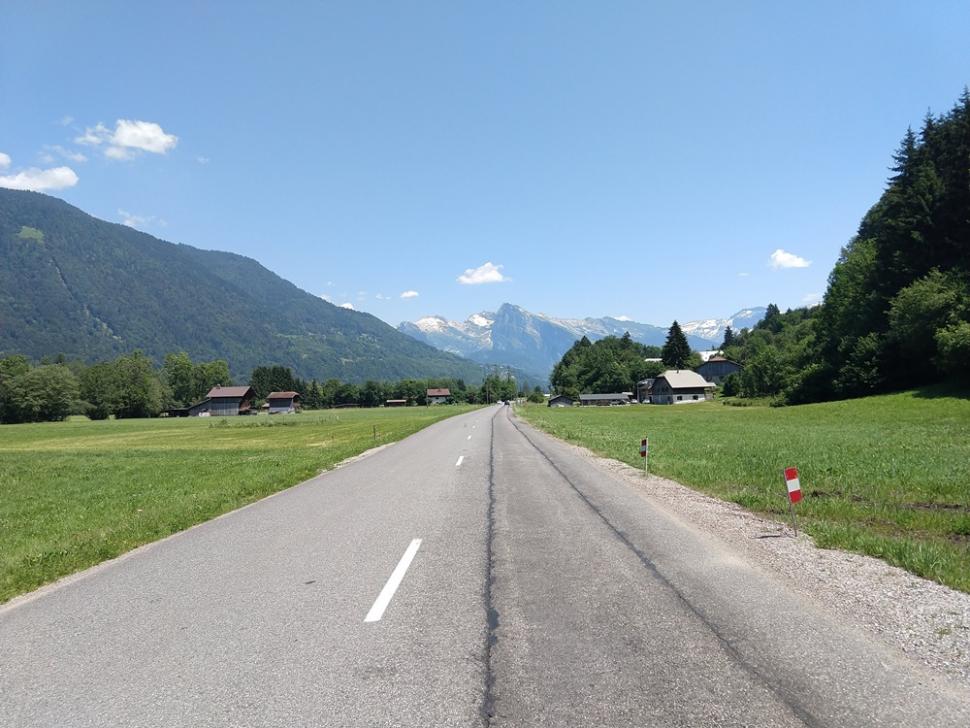
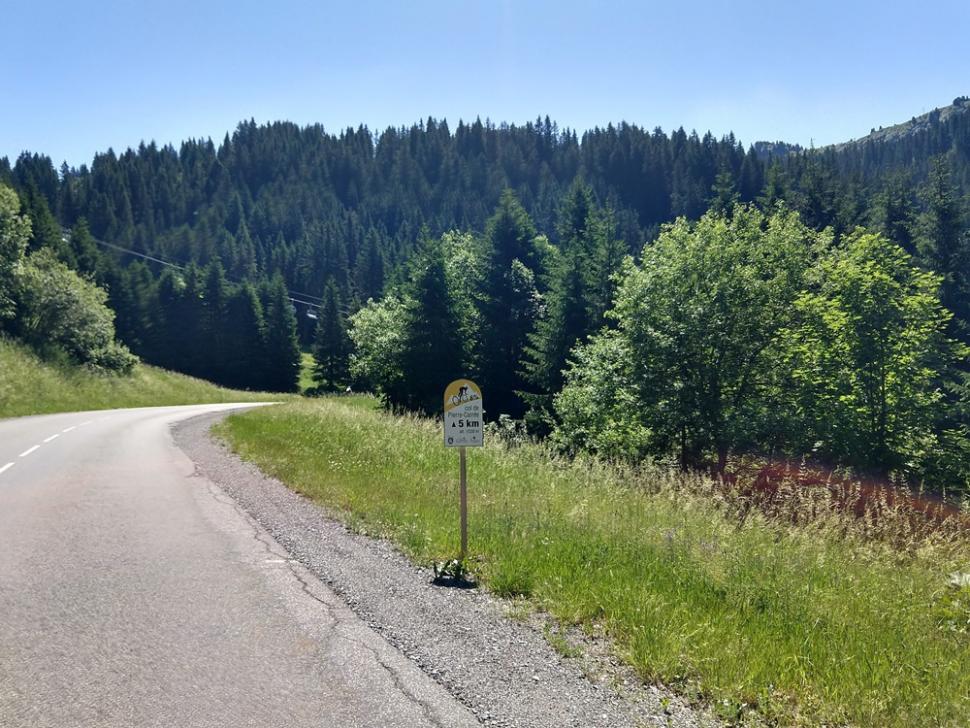

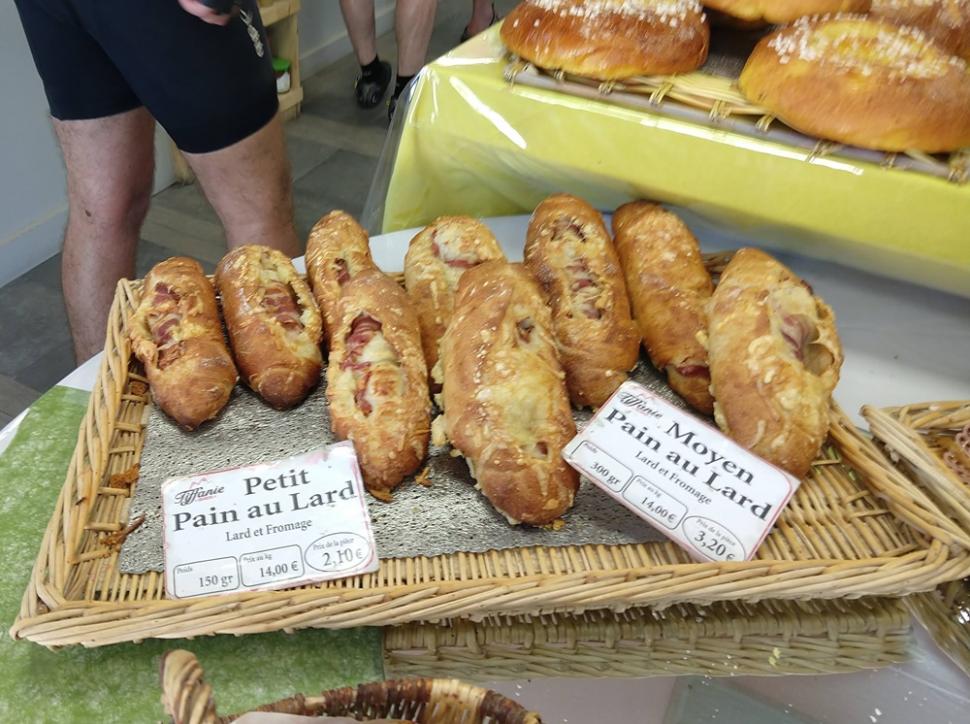
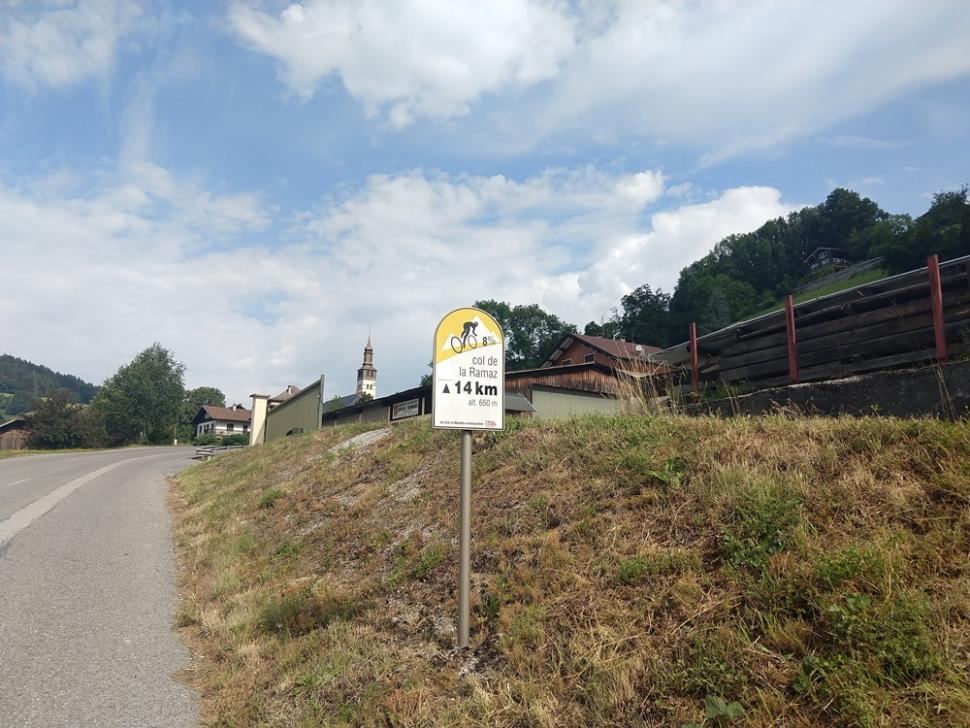



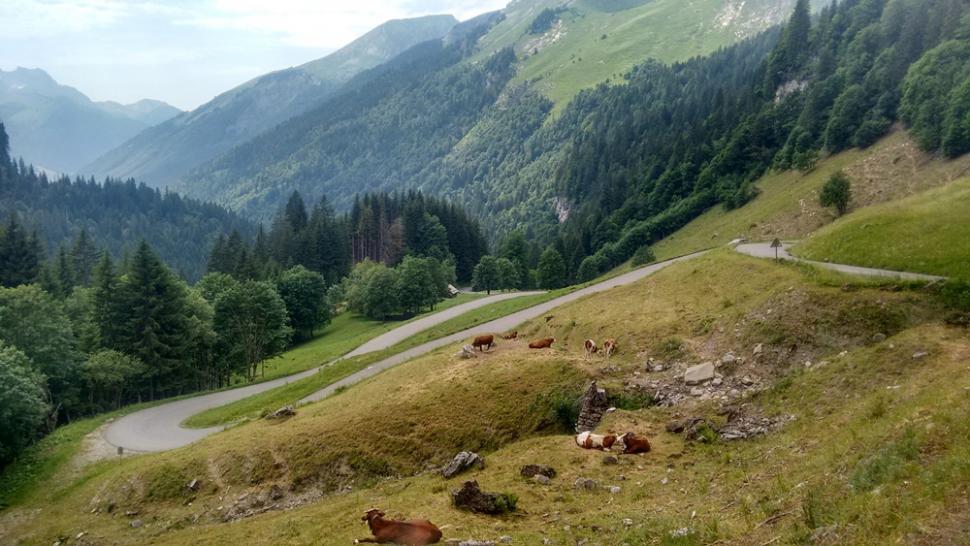
Add new comment
39 comments
A great article. I identified with all of it, especially being a bit of a tubby sod.
More please!
Great article. It felt somewhat familiar though. Maybe its just striking a chord with my memories of cycling round Morzine.
Can we have a "recycled" tag against articles to help those of advancing years? I feel I'm being gaslighted by road.cc
Very enjoyable article.
I once had a really bad crash descending the joux plane towards morzine. Gave me concussion for a few days which was weird and unpleasant.
As others have said That was a great read really enjoyed it.
Not an Alp, but got the opportunity to do Ventoux a few years ago. My mate had rented the bikes and mine was a Cannondale Supersix with a triple crankset. I was so happy to have it, despite a few comments as I overtook people. I don't speak french but I could pick out the word "triple" well enough and I guess the rest of the words amounted to "you are cheating!". I didn't buy a triple, but I bought an 11-30 cassette after that. Does anyone ever regret having a "too easy" gear available?!
Nobody would call you out for cheating with a triple these days, they save that for the e bikes which flock to Ventoux for some bizarre reason. I always have respect for the people who climb using unconventional means: fatbikes, trikes, bikes with kiddy seats etc. Makes those of us with lightweight carbon climbers look soft.
I got passed by a few ebikes. I dont have any issues with them, in fact I'm hoping my wife will one day cycle up an alpine mountain on her town ebike. Its re opened a chance for her to cycle again.
On a custom built bike I had built in 2008, I specced Ultegra triple groupset, on the advice of my physio, as I had been suffering with an achilles problem for a year or so and needed some really easy gears. I have to say I didn't use the small ring much, but when I needed it, I was glad for it. However, triple or compact? Having had both, I would go compact. With the right cassette you can get pretty much the same gears, but you have a smoother ride due to the gear ratios. The Ultegra triple seemed to big a jump between rings.
A great read. Thanks.
The gradient gradings brought a smile of recognition.
You know you're alive when you get to the top of the Mont du Chat (west side). Or in my case, you know you've decided on a compact chainset as soon as possible.
Great read - all the feelings I went through a month ago on my first alpine climb. As well as dreading what gradient the marker posts would say next I also got very angry at them when they weren't exactly a km apart - 'making the climb longer'. Was going through all manner of distractions to try and not think about the never ending gradient.
I meant to say that a couple of the kilometre markers were missing near the top of the Joux Plane. For a time we were extremely troubled by our apparently slow progress. We were then elated to discover we'd fast-forwarded to almost the summit.
Excellent article, great writing.
Brought back memories of my hols in the mountains. I did a French 'alpine classic cols' trip which was wonderful. I remember scooping water out of a stream and tipping it over my head to cool off!
Then I did a Dolomites classic cols trip. The Dolomites are really beautiful, generally steeper and shorter than the French climbs. Monte Zoncolan was absolutely brutal, Fedaia not much better.
I would love to do another tour before I get too old. The french Alps for me had the edge, simply because of the massive scenery. Truly life-affirming.
Spot on in terms of tone and humour.
I guess we'd all like to read more freom Alex Bowden
Agree with the comments - great article with well-judged humour and a very relatable experience of attempting the Alps for the first time. More like this would be great.
Matt Dickson in the Times sums it up perfectly..
https://www.thetimes.co.uk/article/forget-the-nou-camp-or-augusta-the-mo...
It's addictive; I did Alpe d'Huez (my (first) training pass was Ballon d'Alsace) 5 years ago and have been 'ticking others off' ever since. Watched the Tour going up the Tourmalet and I was there in spirit; albeit going a bit slower!
A lovely article, well written with a gentle humour - thanks very much. More of this sort of thing, please!
As a rider who is a little taller than average and slightly broader I can relate to how much much a steady climb is better than a varying one. Whenever I talk about wanting to lose some weight I get funny looks from friends, but I'm a good 5-10kg heavier than I would like to be for getting over the hills, I think if I was planning to have a go at this sort of thing a few months of much stricter dieting is needed.
Good read, I enjoyed that.
Timely reading for me, off to St Jean de Maurienne at the end of the month. Hopefully going to do Telegraphe-Galibier, Glandon, and Alpe D'Huez over the course of four days. However I have been battling a knee injury all summer so am pretty out of shape and have mostly been limited to 50km rides with maybe 1000m of ascent.
Going to be spending a loooong time in the 34-34 gear.
Was in St Jean a month ago. Telegraphe/Galibier was my first ever alpine climb. Just find your gear and settle into a rhythm (also massively helps if you know what limit to set yourself (power or HR) took me to the third day of the trip to find where my tempo should really be going by HR. ) Rather than turn round at the Galibier dropped into the next valley and went all the way round to the Croix de Fer - that was utter torture and the hardest day I've ever had on the bike, but glad I did it - may never get the chance again.
Also would recommend doing Lacets, Col de Chaussy and the Madeleine (also long torture, I was paying for day 1), lunch at the top then back down the Madeleine to St Jean. (Seeing how many buses you can overtake on the way down ) Lacets is only 20mins ride down the road from St Jean and is short but absolutely stunning, switchbacks every 150m and one of my favourites of the week.
) Lacets is only 20mins ride down the road from St Jean and is short but absolutely stunning, switchbacks every 150m and one of my favourites of the week.
Very nice article - and I enjoyed the gentle humour.
Ensure bike is correctly geared, set a pace with a nice cadence 85rpm and spin away for a couple of hours, admire the views and effort at the top.
Excellent article thank you.
I'm back from The Stelvio last week, was very hard. The local tourist info says average 5.5 to 6% was it f%*&! Mostly 8/9/10. I did Ventoux the year before and I reckon two Ventoux ascents is worth one Stelvio.
Loved your gradient gradings. Brought back lots of memories.
I'm doing the umbrail/stelvio, then mortirolo/gavia for my mates 50th in Septmeber...never done any alpine passes, so thought we'd start nice and easy
I will add though, that I have cycled a fair bit in Gran Canaria and i really loved that - sea level to 1900 metres is quite a haul!
Great article though, loved it - really brightened up my day!!
Depends which Ventoux you mean, but Bedoin is rated by climb by bike as 182 in the World. (I reckon Malaucene is harder, they disagree). Stelvio is number 108.
I did the Cinglés this year - the Ventoux triple - that was fun. A couple of weeks later I cruised up Galibier as if it was a ride round Hyde Park by comparison! Galibier is however absolutely stunning.
Malacuene has better views, but is tough. I liked to go back and do the Cingles having ascended two sides of Ventoux. You have got to gear the bike where you can keep your heart rate down below zone 4, ideally lower zone 3 and spin away. I weigh towards 100kg so use a triple groupset and mtb rear gearing. I can slow the pace right down if I want to using the granny ring. That is there for 15% +gradients.
The frustrating thing is, no matter how much you think you've achieved, there is always some bu&&er who did more. The first time I did Ventoux I did it the tourist way. Parked the car in Bedoin and cycled the mere 20km to the top. While patting myself on the back at the top, I noticed the locals who do this as part of a 100km route every weekend. I later became a local, and now do Ventoux regularly from home in the Luberon, a 125km round trip crossing the Monts de Vaucluse in each direction en route, and scoffing at the tourists and their 20km efforts. Ah but then I noticed the Cinglés, all 3 routes in a day, surely that must be the ultimate, so I set out to do that. At my first café stop as I was getting my card stamped, a Belgian guy said "so you're doing the Cinglés huh? I'm on bicinglés." For those who don't know, bicinglés is 6 ascents in 24 hours, 2 by each route. My new Belgian friend had started at 4am, and expected to do his final climb before midnight.
Can't imagine the level of fitness you would need for a bicingles.
Probably not much more than a single Cingles. Speaking personally, if I got around it once, I would find it more of a mental challenge to immediately do it all over again. That's not me blowing my own trumpet - quite the opposite - I'm far weaker mentally than physically when it comes to that sort of ride.
On the marmotte, I bumped into a friend at the last feed stop and it was only him saying, "Imagine going home having climbed Glandon, Telegraphe and Galibier, then parked it because you were a bit tired" that saw me ride to the foot of Alpe d'Huez and start the climb rather than head back to the hotel in Bourg d'Oisans.
Once you're fit enough to get up these things, in whatever time (however fit that is - I suppose it depends what your lowest gear ratio is), it's all mental. IMHO.
Yes, sorry I meant The Cingles. Did it but only just. Bedoin is brutal.
Pages